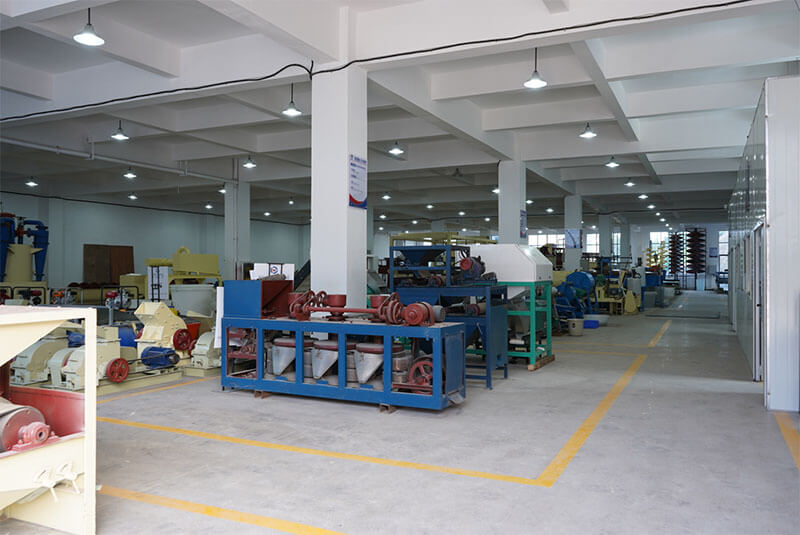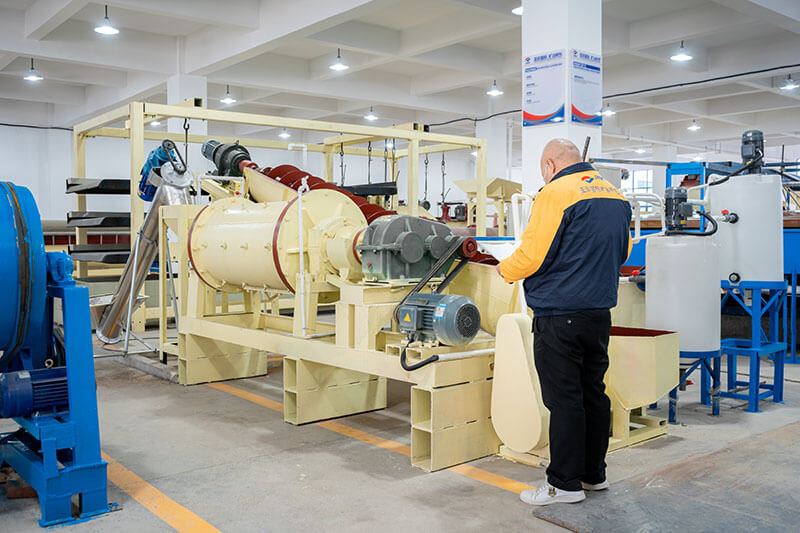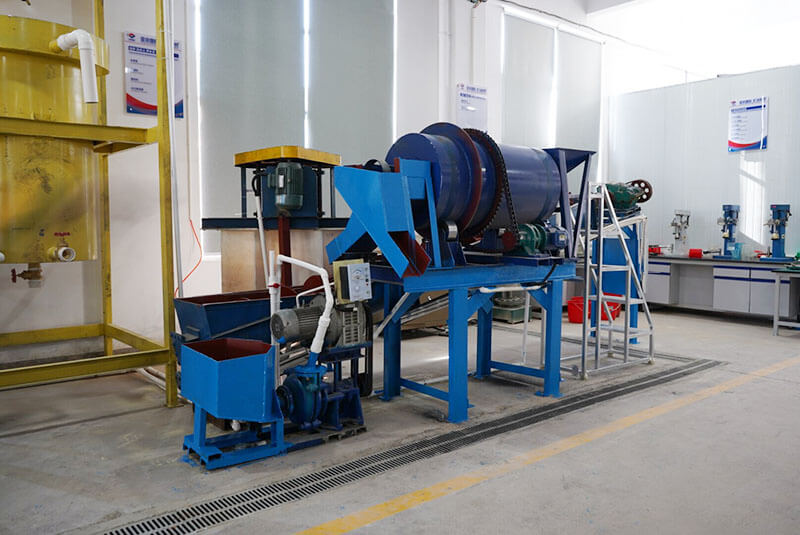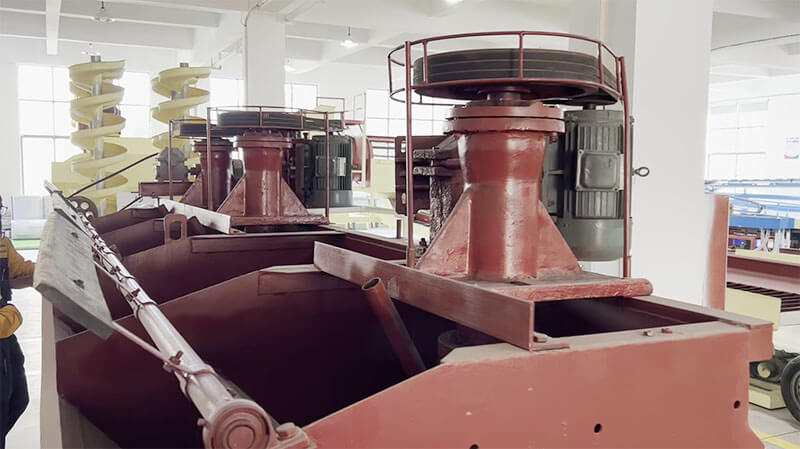Mineral symbiosis refers to the two or more mineral species occurring and interdependent in geological processes. This symbiotic relationship is usually related to the formation and metamorphism of minerals and reflects the geological environment and genesis of ore deposits. There are two types of mineral symbiotic relationships: syngenetic and allogenetic. Syngenetic mineral symbiosis refers to the simultaneous formation of two or more minerals, including chalcopyrite and sphalerite, galena, and chalcopyrite. Xenogenetic mineral symbiosis refers to the formation of one mineral after the formation of another, including calcite and gypsum, dolomite, and calcite. In nature, mineral symbiosis and association are common phenomena, some of which are densely embedded and difficult to separate. Before the establishment of a beneficiation plant, it will take mining testing to determine which equipment to use. Here is the equipment required for the mining beneficiation experiment of tungsten gold and lithium mixed ore. The equipment is crushing machine, gravity separation machine, and flotation equipment.
Lab Tungsten Gold Spodumene Ore Beneficiation Equipment
Lab Tungsten Beneficiation Equipment
Tungsten beneficiation test process:
- The lab jaw crusher and roller crusher crush the material to 0-5mm, and then the material goes to the lab jig separator. The Jig machine is the under-screen jig separator. The finished particle size of tungsten ore is approximately 0-6mm, with most being 0-2mm.
- The tungsten ore tailings are ground to 0-2 mm by a rod mill (which contains steel rods instead of steel balls). Then the ground material goes to a gravity separation shaking table.
- The concentration of the jig is not continuously discharging. When the concentration reaches a certain amount, turn on a switch to discharge the mineral concentrate.
Crushing Process
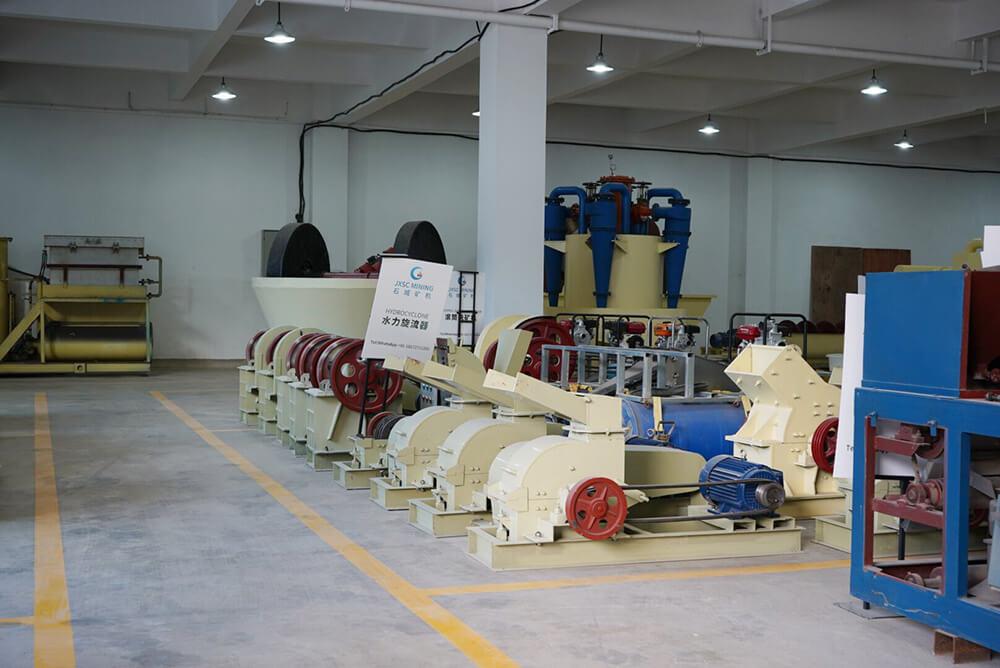
1. Laboratory jaw crusher (tungsten)
- Introduction: It is a preliminary process of crushing large pieces of material into small particles.
- Application: The lab jaw crusher has a wide application in various buildings, aggregate crushing lines, and crushing sections in the mineral processing industry.
- Process materials: granite, marble, basalt, limestone, quartz stone, etc.
- Beneficiation Process: Put 100mm tungsten ore into the jaw crusher from the feeding port, and after starting, the two teeth press against each other, crushing the material into small particles and crushing them to 30-40mm, then discharge them from the discharge port.
2. Laboratory roll crusher (tungsten)
- Introduction: It is for crushing small particle materials into fine sand, suitable for medium and fine crushing operations.
- Application: It has a wide application in mining, thermoelectric, cement ceramics, metallurgy engineering, etc.
- Process materials: iron ore, quartz stone, rock gold, rock tantalum niobium ore, rock tin ore, rock tungsten ore, manganese ore, titanium iron ore, potassium sodium feldspar, limestone, river pebble, copper ore, bauxite, barite, coal, etc.
- Beneficiation Process: The second section of 30-40mm tungsten ore goes to a double roller crusher for second crushing. Through two crushing rods, the material is crushed into smaller particles such as 1-10mm under squeezing, shearing, tooth grinding, and finally discharged from the discharge port.
Grinding Process
3. Laboratory ball mill (tungsten)
- Introduction: It is a grinding equipment for rocks and minerals. Its function is to grind small particle materials into powder form.
- Application: It is suitable for various mineral processing operations (such as rock gold, lithium ore, chromium ore, copper lead zinc ore, etc.) and grinding operations of construction cement.
- Beneficiation Process: Pour the material with a particle size of 25mm into a ball mill. Grind the material into a powder of 0-1mm or 0-200mesh as needed.
Mineral separation process
4. Jig machine (tungsten gold)
- Introduction: Gravity separation is for collecting tungsten and gold concentrates, and the jig machine collects tungsten and gold from 0-5mm through screening.
- Process material: Various mineral processing equipment, such as gold, diamond, tantalum niobium tin, tungsten ore, heavy gold ore, etc.
- Beneficiation Process: Put 0-5mm tungsten ore into the jig, and the sawtooth wave first rises in a straight line, then descends and circulates repeatedly. It uses water as the beneficiation medium and sorts tungsten ore based on the specific gravity difference between tungsten ore and gangue. After a short period of processing, obtain the tungsten concentrate.
- Supplement: we can provide a mobile jig machine as requested.
5. Shaking table(tungsten)
- Introduction: The shaking table is for sorting fine-grained materials and is the gravity beneficiation equipment in mineral processing operations. It is for recovering 0-2mm fine-grained minerals and work with other mining machines.
- Application: The shaking table is for recovering rare and precious metal ores such as gold, silver, copper lead-zinc, tantalum-niobium-tin, iron, manganese, etc.
- Process: Place the 0-1mm tungsten ore into a shaking table. By utilizing mechanical shaking and the flushing effect of water flow, the mineral particles separate according to their density. We can obtain multiple products simultaneously, and the zoning of minerals on the bed surface is obvious.
- Advantages: The enrichment ratio of mineral processing is high, reaching around 300. The beneficiation efficiency is high, and after one beneficiation, obtain the final concentrate and tailings.
- The processing capacity of a single unit is small, with less than 5T per square meter of coarse sand per hour and less than 0.5TPH for fine ore mud.
Gold Separation
In front of the pulsating sluice box and centrifuge, a mixing tank is for mixing the slurry in advance. Then the mixed material is fed into the chute, and the gold concentrate deposite on the pulsating sluice box. The particle size of the concentrate depends on the sluice box from top to bottom, and the larger the particle size of the upper gold concentrate, the finer the particle size of the lower gold concentrate. Tailings are water flowing from top to bottom and outward.
6. Gold Centrifuge Concentrator (gold)
- Introduction: A centrifuge is a gravity separation equipment that separates minerals with significant differences in specific gravity in a centrifugal force field.
- Application: Preliminary enrichment of precious metal concentrates such as placer gold and ground rock gold.
- Process: The centrifugal concentrator’s rotor rotates at a certain number of revolutions at high speed, and the slurry is fed into the inner wall of the drum through two points of the feeding nozzle through the feeding port.
7. Pulsating slide box(gold)
- Introduction: sluice box separation is the intermittent discharge of concentrate, which utilizes the difference in the specific gravity of gold and sand. The slurry flows through the chute, and the gold with a significant weight settles in the bottom layer. The sand with a small specific weight floats in the upper layer and is discharged from the working area with water flow.
- Application: Selection of placer gold and preliminary enrichment of precious metal concentrates.
- Advantages: Its bottom plate and mechanical agitation are for making the bottom plate slowly agitate, overcome sediment compaction, and periodically agitate to complete layering and sand removal, thereby increasing the net separation rate to around 90%.
Laboratory ball mill+screening (grading)+desliming+laboratory flotation machine+vacuum filter (lithium concentrate dehydration)
Lithium ore processing
The double roller crusher crush the material to 0-5mm, then enters the laboratory ball mill (which contains steel balls) for grinding. After about 20 minutes, the finished product is discharged 0-1mm and then graded with a 40 mesh sieve. The larger particles are poured in and ground again, while the smaller ones are prepared to enter the flotation machine.
Before using the flotation machine, remove the mud first. Then precipitate to a certain concentration and place it in the laboratory flotation machine. Add water and chemicals at irregular times. (Dosing agents use pH test paper to determine acidity and alkalinity, and the reaction time varies among different agents, so there are also regulations for the interval time between adding agents.)
When foam appears, use a scraper to scrape out foam. This foam is lithium concentrate.
Foam uses a vacuum filter to dewater the concentrate. And the final concentrate is powder. There will also be a small amount of lithium mica inside.
8. Flotation machine (lithium)
- Product introduction: The SF flotation machine is a commonly used self-aspirated slurry and self-aspirated mining flotation equipment.
- It is equipped with a mechanical mixing device and utilizes an external characteristic fan to forcibly blow in the air. Suitable for rough and sweeping operations in large and medium-sized flotation plants.
- Application: It is for separating non-ferrous metals, ferrous metals, and non-metallic minerals, such as copper ore, lithium ore, fluorite ore, etc.
- Beneficiation Process: after the flow is stabilized through the cover plate, it is evenly dispersed in the tank to form mineralized bubbles, which are scraped out by the scraper and become foam products.
Above is the mining testing equipment for tungsten gold spodumene ore. JXSC lab mineral processing equipment manufacturer has more than 38 years of experience in mining processing. We provide laboratory equipment suitable for minerals such as gold, tin, tungsten, lead, zinc, tantalum, niobium, iron, manganese, silver, titanium-iron, etc. Machines include laboratory jaw crusher, hammer crusher, roller crusher, grinding equipment, mineral separating equipment, screening, washing equipment, etc. Welcome to consult if you are interested in our lab equipment!

